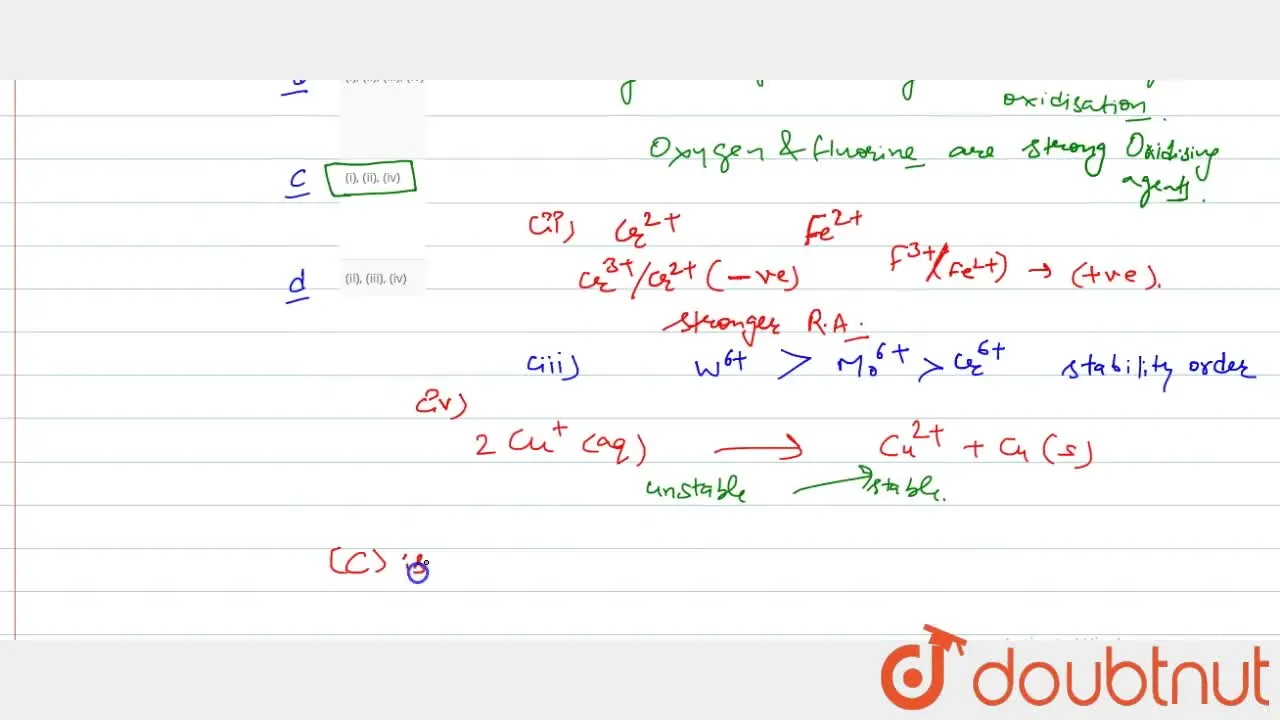Which of the following statements is correct ?
(1) The highst oxidation state of a metal is either xhibited in its oxide or its fluoride
(2) is a stronger reducing agent than
(3) The stability of the +6 state for Group 6 elements
(4) ion is not stable in aqueous solutions
(i), (iii), (iv)
(i), (ii), (iii), (iv)
(i), (ii), (iv)
(ii), (iii), (iv)
The correct Answer is:C
(i) The highest oxidation states are often stabilised in the oxide and fluoride compounds. In these compounds and are difficult to be oxized by the central metal because O and F are strong oxidized agents.
(ii) Reducing agent reduces the other and gets oxidized. is a stronger reducing agent than because is negative whereas is positive . Thus, is easily oxidized to whilt can't be easily oxidized to .
(iii) The trend in the stability of oxidation states within the group is different for d-block elements and the main group elements (s and p-block elements). For the main group elements, the higher oxidation state become less stable elements, the higher oxidation state become less stable going down a group (inert pair effect). However, for the d-block elements the stability of the higher oxidation states increases going down a group. Chromium in the oxidation state is a good oxidizing agent forming as the product. This implies that is more stable than . In contrast, molybdenum and tungsten are not easily reduced when they are in oxidation state and . The most important states for Mo and W are and . Whilst is strongly oxidizing, and are stable. Similarly is stable but and are strongly reducing. The correct stability order of the state for Group 6 elements is . We find the same trend in Ground 4 which is composed of Ti, Zr and Hf. For all the three elements, most stable oxidation state is . However Ti and Ti can be formed form Ti by using good reducing agents but lower oxidation states of Zr and Hf are extremely difficult to prepare.
(iv) (aq) is much more stable than (aq). Although second ionization enrthalpy of Cu is quite large but for (aq) is much more negative than that for (aq). It more than compensates for the second ionization ehthalpy of Cu. Consequently, many compounds are unstabe in aqueous solution and undergo disprortionation as follows:
(aq) (aq)
Going form left to right across 3d-series, (aq) ions are known for the last 8 elements form V to Zn while (aq) ions are known for the first 7 elements form Sc to Co. Thus, there is an overall increase in stability of (aq) with respest to oxidation as one moves across the series. However. In case of iron, (aq) is less stable than (aq) on account of extra stability associated with half-filled subshell in the case of (aq).
Related Playlists
- BOOK - R SHARMACHAPTER - THE D AND F BLOCK ELEMENTSEXERCISE - Follow-up Test 311videos
THE D AND F BLOCK ELEMENTS
- BOOK - R SHARMACHAPTER - THE D AND F BLOCK ELEMENTSEXERCISE - Follow-up Test 418videos
THE D AND F BLOCK ELEMENTS
- BOOK - R SHARMACHAPTER - THE D AND F BLOCK ELEMENTSEXERCISE - Archives54videos
THE D AND F BLOCK ELEMENTS
- BOOK - R SHARMACHAPTER - SURFACE CHEMISTRYEXERCISE - Archives18videos
SURFACE CHEMISTRY
- BOOK - R SHARMACHAPTER - THE P BLOCK ELEMENTSEXERCISE - Archieves62videos
THE P BLOCK ELEMENTS
Similar Questions
Statement-1: the highest oxidation state of transition metal is exhibited in its oxide or fluoride only.
Statement-2: Small size and high electronegativity of O and F can oxidise the metal to its highest oxidation state.View SolutionOxidation state of the metal ion in the complex [Fe(CN)6]3− is
View SolutionThe average oxidation state of sulphur in Na2S4O6 is
View SolutionA metal ion give chocolate coloured ppt with K4[Fe(CN)6]
What is the oxidation state of that metal in its ion ?View SolutionExplain the following observations :
(i) Copper atom has completely field d orbitals (3d10) in its ground state, it is regarded as a transition element.
(ii) Cr2+ is a stronger reducing agent than Fe2+ in aqueous solutions.View SolutionThe average oxidation state of sulphur in Na2S4O6 is
View SolutionThe oxidation number of sulphur in Na2S4O6 is
View SolutionThe average oxidation state of sulphur atom in S4O2−6 ion is
View SolutionStatement-1: Cr2+ is a stronger reducing agent than Fe2+
Statement-2: In aqueous medium d3 is more stable than d5 configuration.View SolutionWhich of the following statements is (are) true for [Cu(NO2)5]4− and [Fe(H2O)6]3+ ?
View Solution


